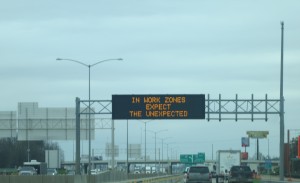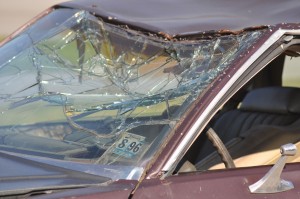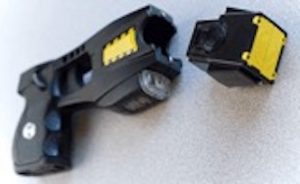KN, p. 140 “On the Road – Avoiding Accidents”
Hi from middle America! Sheila and I are on our way to Texas to visit Bridget on an extended Spring Break. The weather has been great – mostly sunny and dry all the way and even a bit warmer than we’ve been used to lately. Not a snow drift in sight, although we’ve seen many bent and broken evergreens along the highways. There were so many fallen trees in one section of Tennessee that the tops of the trees that interfered with traffic had been sawed off, leaving the rest for later haul away.
The road crews are busy fixing the potholes created by all the snow and ice freezing and thawing the roadbeds. We’ve had a few delays in Tennessee and Arkansas, but the Highway Patrols are doing a great job of letting us know when to merge into one lane. They use some overhead signs and those portable digital signs. Big flashing letters, nice and easy to read from a distance.
It’s about a 1400 mile trip this time, and while most drivers are doing a good job of sharing the road, I think a few of them need to have their licenses revoked. I had a few choice words to say this afternoon while watching some of the idiots, so I thought I’d share a tip or two on how to make the roads safer for the rest of us.
Kerrian’s Handy Driving Tips:
- When you pull out to pass a truck, remember that he cannot see your much lower car unless you can see his head reflected in his side view mirror. He has no idea you are trying to pass him if he can’t see you.
- And, it is not okay to cut off a 16 wheeler. Next time you get that close, he just might roll right over you. Your pretty Lexus might get squashed.
- Tip to keep in mind before moving in front of the car you just passed: You should be able to see their entire car in your rear view mirror. The side view mirror is misleading in terms of distance and makes the car seem much further away than it actually is.
- In most states, if there is an emergency/law enforcement vehicle with flashing lights stopped along the side of the road, you are required by law to move over a lane – away from the flashing lights. You will be ticketed if you violate this rule. In addition, in some states, you must also slow down while passing that vehicle. In Texas, you must drop your speed by 20 mph while passing that stopped vehicle. That means, if the speed limit is only 35, you must drop your speed to 15 mph while passing that stopped vehicle.
- It is not okay to drive to within 5 feet of somebody’s rear bumper at speeds of 75 mph. We’re not playing bumper cars out here.
- It is not okay to weave in and out of traffic, going from lane to lane, while trying to create a third lane out of two. We’re not playing the supporting roles in a James Bond/Jason Statham/Vin Diesel movie.
- We saw three, count ‘em 3, tractor trailers jackknifed on the highway today. One was being hauled out of a ditch. It was still upright, but had tried to avoid a car that cut him off. The truck driver went off the road to avoid killing anyone. That’s what the cop said as we stopped, waiting for the tow truck to maneuver. The driver was fine, but the side of the truck was damaged and he was really annoyed. Further on down the road, the car involved had been caught and that driver was being ticketed.
- Quit texting on your cell phone while you are driving. If the message is that important, pull off the road to text. Better yet, de-stress and turn the phone off.
- Unless you have hands-free capability for your cell phone, if you’re driving, DO NOT ANSWER IT. Some states are moving toward completely banning the use cell phones while driving. In most states, if you’re under the age of 18, it’s illegal to talk and drive.
- Click on the link below to see which states prohibit cell phone use and under what circumstances.
https://en.wikipedia.org/wiki/Restrictions_on_cell_phone_use_while_driving_in_the_United_States
- If you are hauling an open trailer, please tie down whatever you’ve got piled up. Great big bales of fabric/clothes that come flying off the truck and land on somebody’s windshield or on the roadway are not any fun at all to deal with. Flying missiles coming at you at more than 70 mph? Not to mention all the cars now trying to avoid the swerving traffic dodging said junk? Then we get into bumper car territory. With real damage involved.
- Lock up your car when you leave it to get a cup of coffee. Your vacation stuff can be seen thru the windows and while you are waiting in line, thieves can steal not only your iPad, etc. but the car itself. Expensive cup of coffee. In case you thought your possessions in the car are covered by insurance, think again. Most of it isn’t. At all. Check with your car insurance company.
Other Tips for a happier driving experience
Before you get on the road, check the tires for air pressure. Properly inflated tires can actually increase gas mileage.
Join AAA. No, I’m not a paid advertiser for them. But, as a part of their service, they provide free maps and route suggestions and hotel discounts. If your car breaks down along the way, they can usually provide help in under an hour.
If you have a long drive ahead of you like we did, stop every two or three hours. Plan the trip so that you split up the stops for food and gas and bathroom breaks, etc. We used to do all the necessary things at the same stop, but found that we were exhausted at the end of each day. The body needs to move to function at top form. That means getting out of the car to stretch periodically.
Legs cramping up while driving on a long trip? That probably means that you are dehydrated. Take along a case of bottled water for that long drive. An adult should drink about 4 of the 16 oz bottles of water during the day. Trust me, since we’ve changed our car travel routine, we feel pretty good at the end of our 7-9 hours on the road each day, rather than exhausted and cranky.
Take snacks. Exits with access to food can be few and far between in middle America. We drove through a section of mountains the other day that had almost no exits and therefore, limited food or coffee, for almost 100 miles.
Road trips can be great fun. Just use some common sense and think about that risk you take when trying to save a minute or two. Is it worth it? Or would you rather arrive at your destination in one piece?
Most of all, enjoy the ride. 🙂
*Photos by Patti Phillips
*Kerrian is a fictional character, but everything mentioned in this post actually happened during a three-day period of our road trip to Texas during March, 2015.
KN, p. 140 “On the Road – Avoiding Accidents” Read More »









